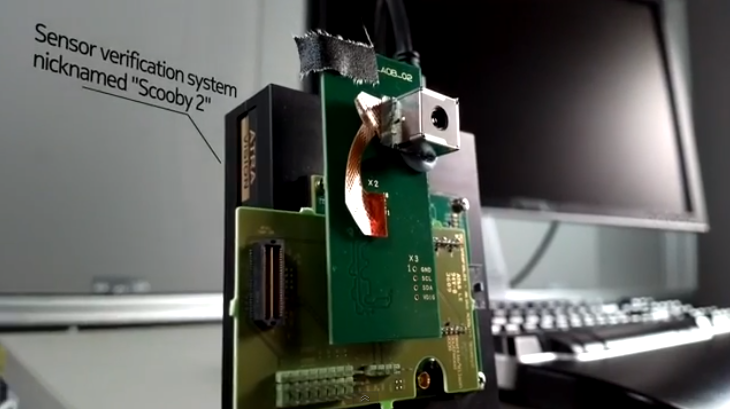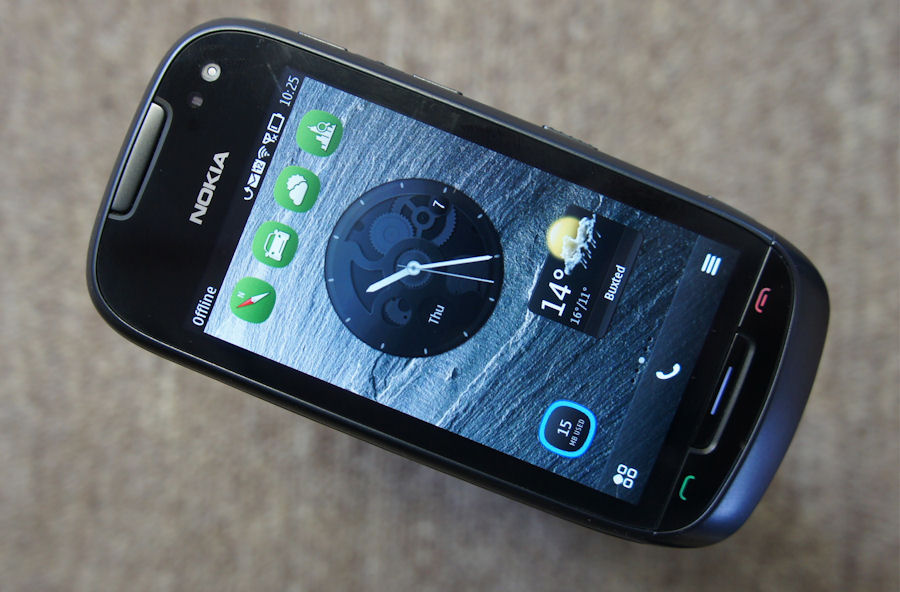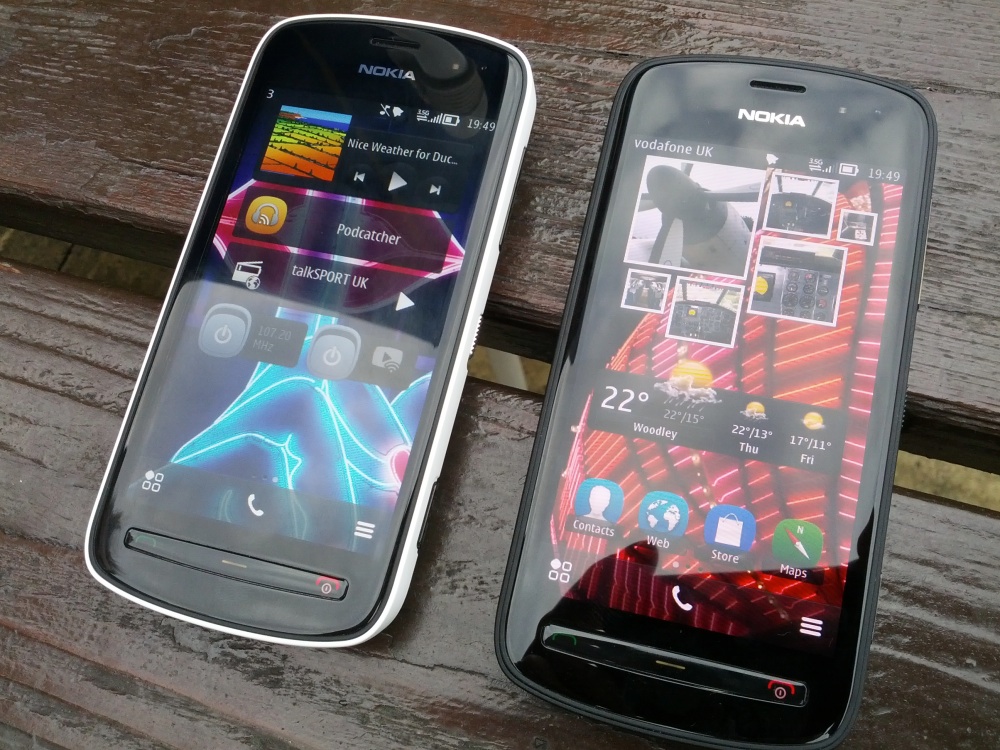I guess I should define 'production' fairly carefully - the Nokia 808 PureView made it into production in that up to half a million were made, but the device wasn't pushed on carriers anywhere in the world and there was almost zero marketing - you had to be a hard core Symbian geek to seek the 808 out and purchase it.
But head back through time to Autumn 2011 and crunch time must have come to the PureView imaging team within Nokia - "when will the new camera be ready?" The answer must have come back along the lines of "Well, we can deliver it on the existing Symbian prototype in under six months. Or you can wait another 18 months (or more) if you want it working properly on a Windows Phone 8 device."

Testing the PureView camera unit in Nokia's labs...
I can imagine that response might not have gone down too well with the top layers of current Nokia management, but the extra delay before the technology could be shown off to the world swung it and the Nokia 808 PureView got a green light for public launch at Mobile World Congress 2012 - and the rest is history, of course.
But what if the management decision had been to forego the 808 and wait until Windows Phone integration was finished? My suggestion to Myriam (tnkgrl) was that the most active 1% of the Symbian community (that includes you, gentle AAS reader) might not have stuck with Symbian this long. Does this ring true with you?
Take the Nokia 808 out of the Symbian device line-up and the next flagship is probably the ever-hard-to-find Nokia 701, with similar core internals to the 808, but with compromised EDoF camera, smaller speaker, less internal storage and smaller, LCD display. It's a great device - or at least it was, the 701 seems rather pale, spec-wise, compared to the rest of the 2013 smartphone world.

Then there are the budget 603 and the diminutive 700 (lovely hardware apart from the terrible camera) - move on, nothing to see.
The X7, with its four Star Trek-like nacelles, two of which were dummies and two of which did their best to muffle the sound from the poorly mounted internal speakers, was unspectacular and unnecessarily sealed in every way. The QWERTY-based E6, launched with it, mid 2011, still has fans (me included) for the keyboard and form factor, but with the focus these days on larger and larger screens it's not surprising that the E6 merely has a 'cult' following in 2013.
What about the 2010 batch of Symbian^3 phones? Upgraded relentlessly (for which much thanks, Nokia), these are still serviceable, but arguably no more than this. The E7 has the stunning keyboard but is disappointing in every other way, while the N8 is still the pick of the bunch and still arguably with the second best real world camera of any phone in the world (if there's call for indoor flash shots, at least), plus there's the aluminium unibody, something which is very much coming back into 'fashion' in the smartphone world. However, even with Belle Refresh, these 2010 devices are showing their age in terms of performance and (in the N8's case) internal storage.
Which just leaves S60 5th Edition devices like the X6 (with its superb stereo speakers and capacitive touch), the N97 mini (in theory a masterstroke of design, in practice let down by terrible battery life) and (perhaps) the venerable 5800, the very first Symbian touchscreen phone from Nokia (other than the abortive 7710 from many years before). All still performing as they were designed to, but all limited in 2013 by RAM and by the very fact that expectations for smartphones have moved on.
[There's also the little matter of the hundreds of millions of non-touch S60 phones out there, but they belong to a very different category of device these days, and I'm going to return to this generation in a future article.]
So, today, in a hypothetical 808-less world, what would you and I be using? I'd bet on:
- 60% having switched to Android, which has many Symbian similarities, yet with more modern (albeit not always perfect) hardware
- 10% might have opted for an easier, less troublesome life and moved to iOS and the iPhone
- 20% might have followed Nokia and its hardware prowess and headed for Windows Phone too
- 10% might have stayed with Symbianm using one of the devices just mentioned
If that last 10% figure seems low, remember that I'm only considering the top 1% of the Symbian community here. The enthusiasts, the ones who seek out articles like this, the people who bother to get involved in comments, in emailing developers, in giving feedback, etc.

Two Nokia 808s, from launch week, in bright outdoor conditions, showing off their screen clarity...
Of course, this is all pointless speculation. Nokia did release the 808 PureView, jokingly referred to by me as 'designed for Steve' (i.e. me) in that everything I'd ever asked for in a Symbian device (aside from QWERTY keyboard, of course!) had been shoehorned into the (sleeker than you might think) form factor. And, significantly, the Nokia 808 soars above the rest of the Symbian world in terms of specs and I'd argue that (all things being considered) it's still competitive with the rest of the smartphone world, mid 2013.
With the 808's release on Symbian, Nokia prolonged the OS's life in many people's eyes by at least a year, if not more. The early adopters, the Symbian enthusiasts, people like you or I, can still rightfully claim "I know exactly what's available in the wider market and the Nokia 808 still does more for me than anything else on sale".
The camera and use of Xenon flash still shocks me with its capability, even to this day. Yes, I matched the 808 with the new Galaxy S4 and pulled off a shock 'tie', but that article didn't really play as much to the 808's strengths as it might have done. Add in a few test shots of people indoors, or of low light landscapes, or of long exposure arty beach scenes, or of super-zoomed sports shots (etc.), and the Galaxy S4 wouldn't, ultimately, have been able to keep up.
The no-holds-barred multitasking, the FM transmitter support, the battery life, the screen clarity, are all without peer - and important to me. I've gone over the full reasons why I've stayed with the 808 PureView before, of course. The simple answer to Myriam and anyone else in the tech world who remains mystified as to why you or I still use Symbian, on the Nokia 808 at least, is that nothing else has come along, on any platform, that can provide equivalent functionality. So why would we (effectively) 'downgrade'?
Yes, an Android flagship (for example) would provide a wonderful selection of cloud-centric applications, mind numbingly good games, intelligent life prediction (Google Now) and a super speedy web browser. But that all has to be set against a battery life of less than a full day, blurry indoor photos, applications which are supposed to stay running and don't, UI fragmentation across the platform, etc.
Comments welcome, as usual...
